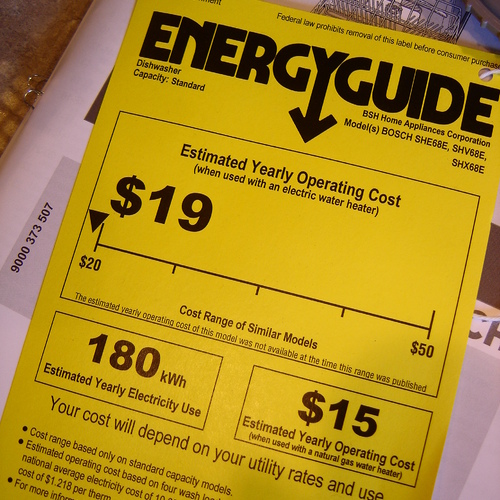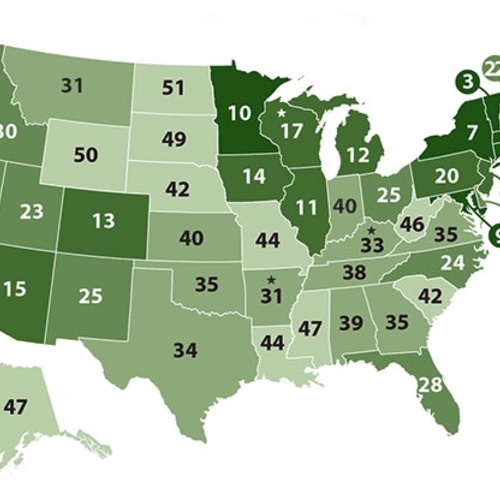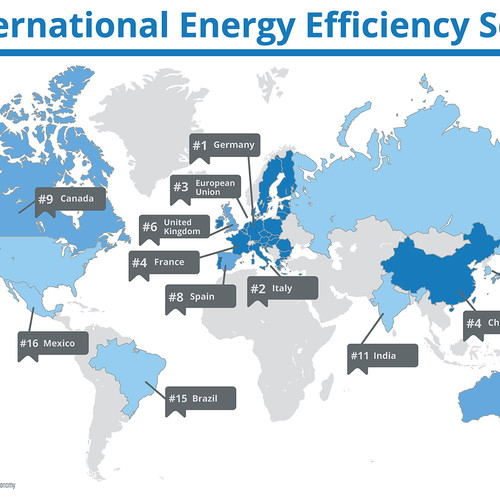
Clean energy, including energy efficiency, has struggled to maintain momentum in a year marked by a global pandemic, racial and social unrest, economic hardship, and subsequent recession. While 2019 saw states adopting ambitious climate goals, 2020 forced governments at all levels to shift priorities to manage the enormous health and economic fallout from COVID-19. However, a new scorecard from the American Council for an Energy-Efficient Economy (ACEEE) points to some bright spots.
The annual ACEEE analysis shows several states adopted energy-saving targets and vehicle or appliance rules that will lay the groundwork to scale up efficiency programs, such as insulating buildings or replacing energy-guzzling appliances. However, while some states are making progress, the scorecard also shows there is still much work to do to ensure that the investment in—and benefits of—efficiency are distributed equitably.
Why is energy efficiency important?
Racial injustice, climate-amped catastrophic wildfires and hurricanes, and the pandemic have highlighted long-standing, deep societal inequities while exposing the high cost of the climate crisis and the vulnerability of communities that are predominately lower income or home to Black, Indigenous, and other people of color. While energy efficiency—using less energy to keep our lights and heat on—cannot solve all of the world’s problems, it is an important part of the answer.
But this can only happen when policies not only target the biggest polluters, but also ensure sufficient investment in efficiency programs is allocated to meet the needs of under-resourced people and communities that have historically been left behind. When done well, equitable efficiency policies can capture energy savings from all sectors and help alleviate high energy costs, improve air quality, build a path to high-quality jobs, and significantly cut climate pollution.
In the last few decades, efficiency has created a cleaner, more affordable and productive economy. Investments in efficiency programs since 1980 have saved consumers nearly $800 billion per year in energy costs, and lowered energy consumption and emissions by 60%.
Such savings are crucial and can free up money for other necessities, as one in five households foregoes necessities like food and medicine to pay their energy bills. Efficiency also avoids unhealthy power-generation pollution that has a disproportionate impact on communities of color.
How did the states rank?
For the first time in four years, California bested Massachusetts as the country’s efficiency leader in ACEEE’s 2020 Scorecard. Massachusetts was second, followed by Vermont, Rhode Island, New York, Maryland, Connecticut, and Washington, D.C., with Minnesota and Oregon tied for number nine.
Most improved went to Nevada, which continued its momentum on utility-sector savings with stronger efficiency goals set through 2021. It also adopted standards for light bulbs, strengthened building energy codes, and implemented strong vehicle standards. Iowa, in contrast, fell farthest in the rankings, plummeting 13 places (to 36th), mostly as a result of 2018 legislation that capped certain efficiency investments and allowed customers to opt out of paying for programs designed to curb electricity and gas consumption.
Who did what?
The scorecard evaluates four areas where states can cut energy consumption.
Appliance Standards
As the federal government stymied efficiency progress, states stepped up. California broadened the scope of its light bulb standards to address bulbs no longer covered under federal standards, and adopted standards for replacement pool pump motors and spray sprinkler bodies.
New York updated its water efficiency standards for faucets, showerheads, toilets, urinals, and drinking fountains, and anticipates it will reduce water use by 3.7 billion gallons in 2025 and 11.3 billion gallons by 2035. Oregon passed sweeping new standards for products ranging from grid-connected water heaters to portable electric spas.
Building efficiency
Several states adopted strengthened residential building energy codes, including Delaware, New Mexico, Vermont, New York, Nebraska, New Jersey, Illinois, Massachusetts, Maryland, and Nevada.
States and communities are also moving toward net-zero energy standards for new and existing construction, which means the buildings must produce at least as much energy as they use.
This includes D.C.’s zero-energy code path, Oregon’s requirement for zero-energy home equivalence by 2023, and Washington’s goal for a 70% reduction in energy consumption in new residential construction by 2030.
California is not only mandating that its new homes be super-efficient, it requires rooftop solar systems for most new construction. Active zero-emissions plans are now in place in Vermont, Rhode Island, the District of Columbia, New York, and Massachusetts.
Utility and Public Benefits
Rhode Island, Massachusetts, Maryland, and Vermont adopted standards requiring utilities to meet a certain percentage of their customers’ energy needs through efficiency improvements. They report savings that equal 2% or more of the amount of electricity they sell, which is the highest levels in the country.
However, the scorecard offers little insight into how well states are ensuring equity in their efficiency programs, making it difficult to fully evaluate their overall progress. Policies and utility funding for low-income programs receives 1 of 20 points in this section. Allocating just 1 point does not provide a full view of how states are prioritizing equity in their efficiency programs. Even so, only about half of the country achieved even 1 point. Giving equity more prominence in the rating process would provide a better assessment of overall state progress.
Washington became the most recent state to adopt California’s vehicle-emissions standards, with Nevada, New Mexico, and Minnesota signaling their intent to follow.
What’s next?
In each area, it is equally critical to evaluate how successful state policies and investments are in serving those most in need, such as lower income communities and people of color. We continue to face unprecedented times, making efficiency one component of a much-needed broader approach to build back better in an equitable manner to ensure everyone enjoys clean air, healthy and comfortable living environments, quality jobs, and affordable energy. Even as the federal government heads in a new direction under President-elect Joe Biden, states will continue to pave the way for a cleaner and more equitable future.
Lara Ettenson is director, energy efficiency initiative, climate & clean energy program at the Natural Resources Defense Council. This post originally appeared at the NRDC Expert Blog.
Weekly Newsletter
Get building science and energy efficiency advice, plus special offers, in your inbox.















18 Comments
Interesting that the efficiency map looks very similar to an electoral vote map of the US.
It should be no surprise that the top 3 states in terms of housing shortages also rank in the top based upon the ACEEE metric.
http://www.freddiemac.com/blog/research_and_analysis/20200304_states_with_the_lowest_housing_supply.page
Yes --- everyone wants to live in places that do the right thing. Guess why places like MS and LA are at the bottom? No investment in communities so you have places nobody wants to live and cheaper housing.
So why are people leaving California and Oregon?
https://calmatters.org/newsletters/whatmatters/2020/12/californias-population-growth-hits-record-lows/
https://www.qualityinfo.org/-/oregon-s-2019-natural-population-increase-was-the-lowest-on-record
Easy to bash California, but I don't think this aspect comes even close to explaining it.
People in Boise worry about Californians taking over. Thirty thousand from the Golden State, would add about 10% to Boise, and would amount to 7/100s of 1%. People move out of and into states all the time. California has some disturbing trends population wise, but those have more to do with internal demographics. Population has flattened it is not going down...yet. I might be better explained by people NOT going there. People move there for the same reasons they always have, weather, tech, entertainment and a fresh start. The US owes a debt to CA, for how they have driven the efficiency train. High prices come from high demand. That means people want to be there.
The cost of housing is out of sight on the West coast so people are relocating. I talked with a builder in Bend, OR last year and the run up in housing prices had hit there as well. Folks were relocating from CA and bringing demand with them. Along with those high home prices will come increased valuations and higher property taxes.
I think the first reaction from many individuals to an energy scorecard like this is resentment. I think there is some confusion about cause and effect though. California is historically a desirable place to live because of its natural beauty and mild climate. That comes with some baggage, namely overpopulation and high housing prices. There is nothing mysterious about that.
I know many people would like to blame a strict regulatory climate in California for people moving out. The fact of the matter is that the amount of people moving to California in previous eras was just unsustainable. The large increases in population in many centers of population is what has caused the lowering of the standard of living in those areas, including homelessness. It's simply backward to blame it on a strict regulatory climate causing this.
One should think of it like any other physical aspect in nature or in markets. When a very high distribution of assets in one particular region of the country creates immigration to that place then it will eventually become unsustainable as that population increases. The way to deal with that asset, natural beauty and mild climate in California, is to use that as a reason to increase environmental regulations for both the good of the natural environment and to put pressure on people choosing to live here.
In other words, California can afford to discourage people to keep coming here. Do you think most people would ever choose to move to Iowa if they had the regulatory climate we do? Iowa knows they need all the help they can get to just keep the population they have. More importantly Iowa needs to work hard to keep people. California does not. Don't ever confuse the regulatory climate in California as a bad thing. It's a necessary thing to keep things more or less in balance with the population pressures that exist here..
I'm guessing you make regular visits to your dispensary...
CA is loosing population, and billions in debt, has population, and housing issues because of their terrible policy, and extreme government overreach.
Which would be fine, the problem is that all the people who voted and turned CA into the shithole it is now, are running away to other good states, and instead of learning from what forced them out, they are doing the same thing over, and starting to ruin them.
I'm not leaving California you'll be happy to hear and I'm very happy here where I live. My house is paid for and the population 5000 town I live in is beautiful.
Also, my neighbors are friendly and mostly nonjudgemental. I doubt that your neighbors could say the same based on your outburst.
The problem with California is that the culture of NIMBY has insured high regulatory burdens with regards to increasing the supply of high density housing. Not everyone can afford to live in a $2M 90-yr old bungalow with solar panels on the roof.
Oregon for example, well specifically the city of Portland has enacted strict zoning laws which have basically outlawed 2-4 unit dwellings.
Nothing new here.
People have been leaving the state for decades, running up the prices where ever land. OR, WA, ID, NV, CO, etc.
But there have always been more people moving in, than out. Though the influx has subsided a bit.
Economy.
There, I said something cryptic and maybe really smart if you just use your imagination.
Or maybe you should say "economics." It applies to energy efficiency and it applies to who lives in what state.
Economics regarding energy efficiency -- I prefer efficient products because even though they may cost more up front, they usually pay for themselves in savings. But maybe my all-electric double stud home won't pay for its cost, I don't know yet. But it will also be comfortable, something that drove my economic choices in building it. I also think energy efficiency means that we can then stretch out the supply of fossil fuels to last even longer and give us more time to bring online other energy sources.
Economics regarding where you live -- CA does have a mild climate and beautiful scenery. I was born there, grew up there. But I moved away for good. Why? I weighed my economic options. The high housing costs might mean that there is demand to live there. But once demand makes the price high, the demand drops off, so it is no surprise that the population growth there is way down. However it is also my impression that record numbers of businesses are leaving CA due to high cost of doing business. That is also a deterrent to living there. I had a good job and due to some wise planning I was able to pay off my home. But I still moved away. Why? Because the weather and scenery were outweighed by the negatives of dense population (traffic, higher costs for everything not just housing, more crime, etc). I've relocated to the countryside in another state with some space for gardens and stretching out a little, neighbors that actually know and help each other, hardly any crime, etc. CA is just not worth it for me and it was an economic decision, not just dollars, but what am I willing to pay for quality of life. CA just didn't have very many places with the quality of life that I want.
No matter where you live or choose to move, efficiency is good because after the initial investment those dollars circulate back to the community. We all benefit. Even better if local labor and materials are employed in these energy reduction efforts.
For the love of god, can we please stop posting these bullshit political opinion articles on a efficient building website???
Green building is about more than just how efficiently our buildings operate.
Thank you stating that. Being a leader isn’t always easy and often times entails a talk g a few shots. And thanks for the work you do.
This article didn't read as political or propagandistic to me. It's an update on how well (or poorly) state's are using public policy to address climate change, which seems pretty central to what Green Building Advisor is all about.
In any case, there is no way to win the type of partisan exchange that's taken hold in this thread. So let's give it a rest, guys. Historically, GBA participants understand this reality and try to steer clear of those types of conversations. This civility is one of the things I truly love about the site.
Log in or create an account to post a comment.
Sign up Log in